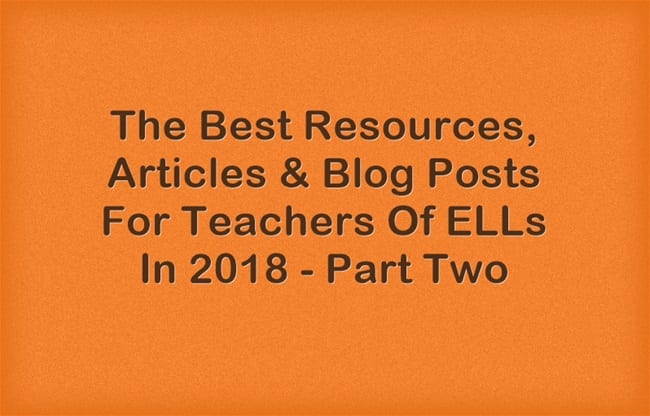This is one of my final end-of-year “Best” lists.
I’m adding list list to All My End-Of-Year “Best” Lists For 2018 In One Place!
You can find previous editions of this list, along with all “Best” lists related to ELL instruction, here.
Here are my choices:
Over the past few months, I’ve published several series of guest posts from teachers of English Language Learners: one on teaching math, another on ELLs and Special Needs, yet another on teaching Science to ELLs, and one on teaching Social Studies to ELLs. I also published a mini-series on evaluating foreign transcripts. And I posted as series on teaching writing.
Here are some others:
GUEST POST: SOCRATIC SEMINAR WITH ELS? CAN DO!
I created this simple downloadable list of ELL accommodations for the faculty at my school, and I thought readers of this blog might or might not find it useful.
THE BEST PODCASTS FOR ESL/ELL/ELT TEACHERS
THE BEST RESEARCH ABOUT THE BEST AGES FOR ELLS TO LEARN ENGLISH
“THE TOP BLOGS AND RESOURCE SITES FOR TEACHERS OF ENGLISH LANGUAGE LEARNERS”
4 Fun Ways to Practice Short Oral Presentations is the headline of yet another excerpt from our book, The ELL Teacher’s Toolbox. It appears in Middleweb. I’m adding it to all the other free resources available from the book.
The 5 Stages Of Second Language Acquisition is from Bilingual Kidspot.
Clozemaster is a free online tool for students to learn different languages. I’m adding it to The Best Beginner, Intermediate & Advanced English Language Learner Sites.
Ed Week has a great multi-part series on dual language instruction. You can see all the links to the series here.
18 Ways to Support Your English Learners is by Valentina Gonzalez. I’m adding it to the same list.
TEACHER’S TOOLKIT LITE v.1 is from ELT-Cation. It’s a simple phone app designed for ELL teachers, and it’s pretty cool.
Making Students’ Assets Our #1 Teaching Priority is by Valentina Gonzalez. I’m adding it to The Best Posts On Looking At Our Students Through The Lens Of Assets & Not Deficits.
How much English do non-english children learn outside the classroom? is a post by Pedro De Bruyckere about a very interesting study. Here’s a quote from it:
The three most important types of input for children’s language proficiency were: use of social media in English, gaming in English, and speaking English. These three types of exposure are the types which offer ample opportunities for social interaction and authentic communication in contrast with watching television, listening to music, and reading, which are far less interactive. Apparently, passive perception of a language is less effective than active use of the language,…”
I wonder what implications this research might have for Krashen’s input hypothesis?
Speaking Goal Cards are from Tan Huynh. You can read more about them here. I’m adding it to The Best Sites To Practice Speaking English.
Parallel Text is a free online site that provides split screen bilingual (many languages are available) texts of a small number of public domain classic works. Even though the text selection is limited, I’m still adding it to The Best Multilingual & Bilingual Sites For Learning English.
Animate your Classes with Video! is a post from Oxford University Press about how to use videos from their Let’s Go ELL series. It appears to me that all their videos and related teaching materialsare also free. I’m adding it to The Best Popular Movies/TV Shows For ESL/EFL.
One Sentence Games is an excellent post by Svetlana Kandybovich.
My TOP 3 Posts this year! They include @TanELLclassroom‘s Interview on How Lessons Fail ELs, My @WIDAConsortium Hacking Literacy breakout & How to Set Up A Classroom for Day 1 w @FourthOnTheHill . ✔️Check them out here: https://t.co/iqGXKmc80F #ellchat #ellchat_bkclub #ELs pic.twitter.com/eC1DBGXbeo
— Carol Salva (@MsSalvac) November 21, 2018
The Office of English Language Acquisition has come up with two more “Fast Facts” infographics: English Learners (ELs) and College and Career Readiness and National and State-Level High School Graduation Rates for English Learners. That second one has some pretty wild and scary statistics. I’m adding it to The Best Ways To Keep-Up With Current ELL/ESL/EFL News & Research.
Developing Learner Autonomy: A Homework Choice Board is from On The Same Page. I’m adding it to The Best Resources For Learning About Homework Issues.
Roll a Dice is from a Journey In TEFL.
Awaken English has some Arabic translations that can help with student Writing Frames. I’m adding it to The Best Scaffolded Writing Frames For Students.
10 Ways to Value ELs’ Language Assets is from Tonya Ward Singer. I’m adding it to The Best Posts On Looking At Our Students Through The Lens Of Assets & Not Deficits.
What If My Middle Level EL Student Can’t Read? is by Valentina Gonzalez at Middleweb.
Using graphic organizers as scaffolds while listening is from Cambridge University Press. I’m adding it to The Best Listening Sites For English Language Learners.
WeSpeke provides “Free English lessons based on authentic CNN news articles, powered by WeSpeke.”
Wordeys is a language-learning online flashcard site.
Linguacuisine is a site that using cooking to help teach English and other languages. Thanks to Nik Peachey for the tip.
Critical Material For Critical Thinking is from The British Council. I’m adding it to The Best Resources On Teaching & Learning Critical Thinking In The Classroom.
Higher Order Thinking Skills (HOTS) is from the British Council. I’m adding it to The Best Resources For Helping Teachers Use Bloom’s Taxonomy In The Classroom.
Empowering Newcomers is by Emily Francis.
WordBooster lets teachers paste-in any text and it will automatically provide related vocabulary exercises. You can read all about it at Nik Peachey’s blog post. I’m not a huge fan of these kind of automatic worksheet producers and, though this one allows you to make edits, I’m just not sure it’s worth the time. But I might be wrong – it wouldn’t be the first or last time.
I previously posted “En.News” Looks Like A Good Site For Intermediate ELLs To Learn About Vocabulary & Current Events. I’ve now learned that teachers can create free virtual classrooms to monitor student progress at the site. Just go here to register. I’m adding this info to The Best Sites Where Students Can Work Independently & Let Teachers Check On Progress.
CaptionCat shares a new photo everyday and then people can contribute…captions. Some on the site may be off-color, but the photos can be used by teachers. I’m adding it to The Best Ways To Use Photos In Lessons.
Getting It Right:Reference Guides for Registering Students with Non-English Names, 2nd Edition is from The Institute of Education Sciences. Thanks to Katie Toppel on Twitter. I’m adding it to The Best Resources On The Importance Of Correctly Pronouncing Student Names. The first edition is already on that list, but this new addition is….new.
New FreeBIE Resource: English Learner Scaffolds for PBL is from The Buck Institute. I’m adding it to The Best Sites For Cooperative Learning Ideas.
100 Top Youtube Videos For Teaching English is from David Deubelbeiss. I’m adding it to The Best Popular Movies/TV Shows For ESL/EFL.
The latest research on teaching vocabulary is from The Language Teacher Toolkit. I’m adding it to The Best Sites Where ELL’s Can Learn Vocabulary.
Carol Salva published this great video, “Top Tips for a Strong Start in the Newcomer Classroom.” I’m adding it to The Best Resources For Planning The First Days Of School:
Study: Shared Book Reading Boosts English-Learners’ Language Skills is from Ed Week.
No drama: Improvisation in the ELT classroom is from GERALDINETEACHER. I’m adding it to The Best Resources On Using Drama In The Classroom and to The Best Resources On Using Improvisation In The ESL/EFL/ELL Classroom.
What the Research Says on Instruction for English Learners Across Subject Areas is from Education Northwest. I’m adding it to The Best Sites For Learning Strategies To Teach ELL’s In Content Classes.
Nine Box Grid – Modified and Magnified is by Kirsten Foti.
Fast Facts is a great collection of research info on ELLs from the National Clearinghouse for English Language Acquisition (NCELA). I’m adding it to The Best Ways To Keep-Up With Current ELL/ESL/EFL News & Research.
Jana Echevarria interviews Valentina Gonazalez and Katie Toppel in this post: Helping English Learners Read Well
I didn’t understand most of this paper, Predicting Time to Reclassification for English Learners, but I did “get” this paragraph:
Robinson (2011) found that, in the district he studied, reclassification had a null effect on reading achievement for students in elementary and middle grades, but significant negative effect for students in high school, suggesting no evidence that the cutoff was inappropriately set in younger grades, but that students in later grades did not appear to benefit from having EL services reduced or discontinued. Robinson-Cimpian and Thompson (2016) also looked at how changes in reclassification criteria over time impacted achievement and graduation rates. They found that higher reclassification benchmarks were associated with a 0.18 standard deviation (SD) increase in reading achievement and a 11 percentage point increase in graduation rates.
I’m adding it to The Best Resources For Learning About The Ins & Outs Of Reclassifying ELLs.
6 Tips When Discussing Math with the English Language Learner is from The Early Math Collaborative. I’m adding it to The Best Resources For Teaching Common Core Math To English Language Learners.
Valuing Our English Language Learners by Learning to Listen is by Wendi Pillars.
Educators Guide for Inquiry-based Science and English Language Development is from The Exploratorium. I’m adding it to The Best Resources For Teaching The Next Generation Science Standards To English Language Learners.
STRATEGIES I USE TO ENCOURAGE STUDENTS TO DO ADDITIONAL ACADEMIC WORK OUTSIDE OF CLASS
AN OUTLINE FOR HOW STUDENTS CAN LEARN TO WRITE ESSAYS INDUCTIVELY
THE DEMONIZATION OF IMMIGRANTS AS INVADERS, AND WHAT TEACHERS & STUDENTS CAN DO ABOUT IT
UPDATE ON VISUALIZATION ACTIVITIES I’M DOING WITH ELL STUDENTS
MY SIMPLE EMPATHY LESSON, PLUS A TON OF OTHER RELATED RESOURCES
The American Educator, the excellent publication from the American Federation of Teachers, published an exceptional issue on teaching English Language Learners – all its articles are available for free online. Among them is one that Katie Hull and I wrote titled Teaching English Language Learners: Tips From The Classroom. Check it out and let us know what you think. I’m adding it to The Best Advice To Content Teachers About Supporting English Language Learners.
TWO “WRITING FRAMES” FOR ELLS & EVERYBODY ELSE
THREE NEW USEFUL RESOURCES ON HOW WE CAN SUPPORT IMMIGRANT STUDENTS & THEIR FAMILIES
GOOD ARTICLE & PODCAST ABOUT OUR SCHOOL’S HOME VISITING PROGRAM
NEW STUDY FINDS A SPECIFIC FORM OF “COLLABORATION” GETS THE BEST RESULTS
“YOUR AGORA” HAS THE POTENTIAL TO BE A GREAT VIRTUAL CLASSROOM FOR ENGLISH LANGUAGE LEARNERS
NEAT TEACHER-CREATED ANCHOR CHARTS/POSTERS ABOUT OUR “ELL TEACHER’S TOOLBOX” BOOK
GUEST POST: PEER TUTORS WRITE ABOUT THEIR SUMMER SCHOOL EXPERIENCE HELPING ELL NEWCOMERS
YOU HAVE AN ACCENT, I HAVE AN ACCENT, EVERYBODY HAS AN ACCENT….




Recent Comments